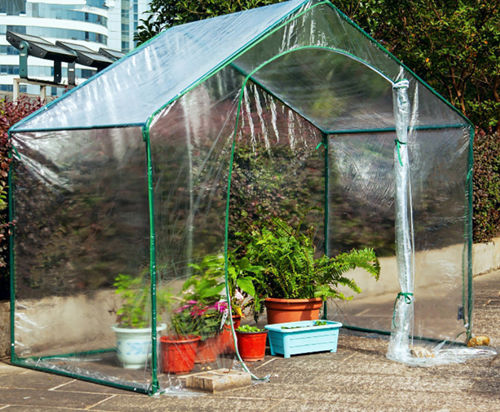A Comprehensive Guide to Choosing the Right Greenhouse Tunnel
Are you an avid gardener looking to extend your growing season? Or a commercial grower seeking to increase production and yield? Either way, a tunnel greenhouse could be the perfect solution for you. Greenhouse tunnels, also known as high tunnels or hoop houses, have become increasingly popular among growers looking to extend their growing season and protect their crops from cold weather. Compared to traditional greenhouses, tunnel greenhouses are typically more affordable and easier to set up, making them a popular choice for both small-scale and large-scale growers. In this article, we will discuss the various factors to consider when selecting a greenhouse tunnel, as well as the advantages and disadvantages of different types of greenhouse tunnels.
What is a Tunnel Greenhouse?
A tunnel greenhouse is a type of high tunnel or hoop house that extends your growing season and protects your crops from cold weather and other harsh conditions. It consists of a galvanized metal frame covered with a durable plastic film, allowing natural light and warmth to enter while keeping out rain, wind, and pests.

Are Polytunnels as Good as Greenhouses?
While polytunnels and greenhouses share some similarities, they have some significant differences. A polytunnel is a type of tunnel greenhouse made entirely of polyethylene film, while a greenhouse typically has a more solid structure made of glass or polycarbonate. Polytunnels are generally less expensive than traditional greenhouses and can be easier to assemble and disassemble. However, they may not be as sturdy or long-lasting as traditional greenhouses and may require more maintenance.
Do Tunnel Greenhouses Work?
Yes, tunnel greenhouses are an effective way to protect your crops and extend your growing season. They provide a controlled environment for your plants, protecting them from harsh weather conditions such as cold, wind, and rain. The plastic cover allows for natural light and warmth to enter, which encourages plant growth and production.
How Much Does a Tunnel Greenhouse Cost?
Roughly US$ 110, Width 2m, Length:3m, Height:2m, Galvanized steel pipe, size:25mm x 0.7mm, with 2 doors and 6 windows, and some necessary accessories.
The price of a tunnel greenhouse can vary depending on its size, materials, and features. A basic, smaller-sized tunnel greenhouse may cost a few hundred dollars, while a larger, more advanced model can cost several thousand dollars. Additionally, the cost of shipping, assembly, and installation should be taken into account when determining the final price.
What are the Benefits of a Tunnel Greenhouse?
Tunnel greenhouses offer numerous benefits for both commercial and personal growers. Here are some of the most notable advantages:
Extended growing season: Tunnel greenhouses provide a controlled environment that allows growers to start planting earlier in the season and continue growing later into the fall or winter.
Protection from harsh weather: The plastic cover protects crops from harsh weather such as cold, wind, and rain.
Increased production: Tunnel greenhouses provide an optimal growing environment that can increase crop yields and production.
Space-saving: Tunnel greenhouses can be an excellent option for growers with limited space, as they can be constructed in small areas.
Cost-effective: Tunnel greenhouses are typically less expensive than traditional greenhouses, making them an affordable option for growers on a budget.
What are the Advantages of Tunnel Greenhouses?
In addition to the benefits listed above, tunnel greenhouses have some specific advantages over other greenhouse types. These advantages include:
1. Durability: Tunnel greenhouses are built to withstand harsh weather conditions, making them a durable option for growers.
2. Versatility: Tunnel greenhouses can be used for a variety of crops, including fruits, vegetables, and flowers.
3. Easy assembly: Many tunnel greenhouse kits come with pre-cut and pre-drilled parts, making assembly easy and hassle-free.
4. Ventilation: Tunnel greenhouses can be equipped with proper ventilation systems to control temperature and humidity levels.
5. Portability: Tunnel greenhouses can be easily moved from one location to another if necessary.
What are the Disadvantages of Polytunnels?
While polytunnels offer many benefits, they also have some drawbacks that growers should consider. These disadvantages include:
While greenhouse tunnels offer many advantages, they also have some disadvantages. One of the biggest disadvantages is that certain crops may not grow well in a tunnel greenhouse, such as those that require a very specific environment or those that need a lot of space to grow. Another disadvantage is that greenhouse tunnels may not be as durable as traditional greenhouses, especially in areas with high winds or heavy snow loads. Additionally, greenhouse tunnels may not provide as much ventilation as traditional greenhouses, which can lead to issues with humidity and disease.
Types of Greenhouse Tunnels
When it comes to greenhouse tunnels, there are several types to choose from, including hoop houses, high tunnels, and traditional greenhouses. Hoop houses are typically the most affordable and easiest to set up, but they may not be as sturdy as high tunnels or traditional greenhouses. High tunnels are similar to hoop houses but are typically taller and wider, providing more space for growers to work in. Traditional greenhouses are typically the most expensive option, but they offer the most protection and control over the growing environment.
Factors to Consider When Selecting a Greenhouse Tunnel
When selecting a greenhouse tunnel, there are several factors to consider, such as size, frame material, and price. Galvanized steel frames are typically the most durable option, but they may be more expensive than other materials such as PVC or wood. It's also important to consider the size of the greenhouse tunnel, as well as the types of crops you plan to grow inside it. Additionally, it's important to consider shipping and customer service options when shopping for a greenhouse tunnel, as well as any additional items you may need to purchase to complete the setup process.
Greenhouse Tunnels vs. Traditional Greenhouses
When it comes to choosing between greenhouse tunnels and traditional greenhouses, there are pros and cons to both options. While traditional greenhouses offer more control over the growing environment and may be more durable in some cases, they are typically more expensive and may require more space. On the other hand, greenhouse tunnels are typically more affordable and easier to set up, but may not offer as much control over the growing environment and may not be as durable as traditional greenhouses.
Conclusion
In conclusion, greenhouse tunnels are a popular choice for growers looking to extend their growing season and protect their crops from environmental factors. When selecting a greenhouse tunnel, it's important to consider factors such as size, frame material, and price, as well as the types of crops you plan to grow inside it. While greenhouse tunnels may not be the best option for every grower, they offer many advantages and are a great option for those looking to get started with growing their own crops.

